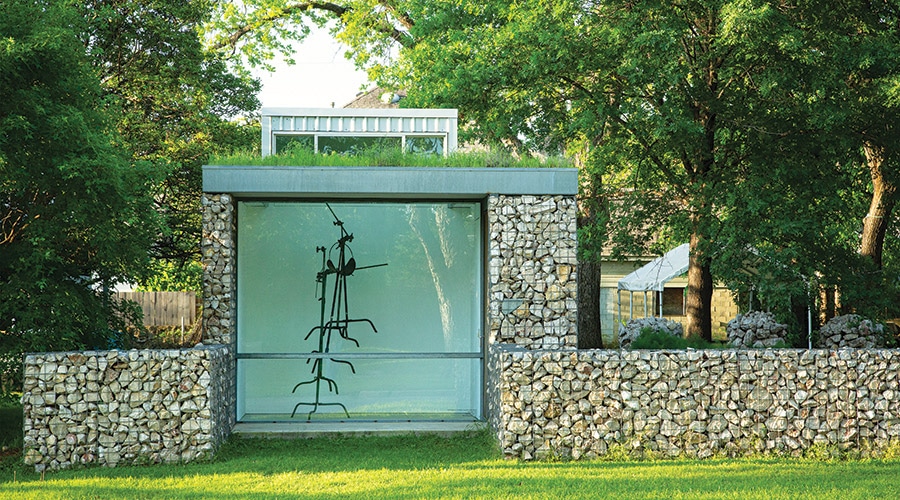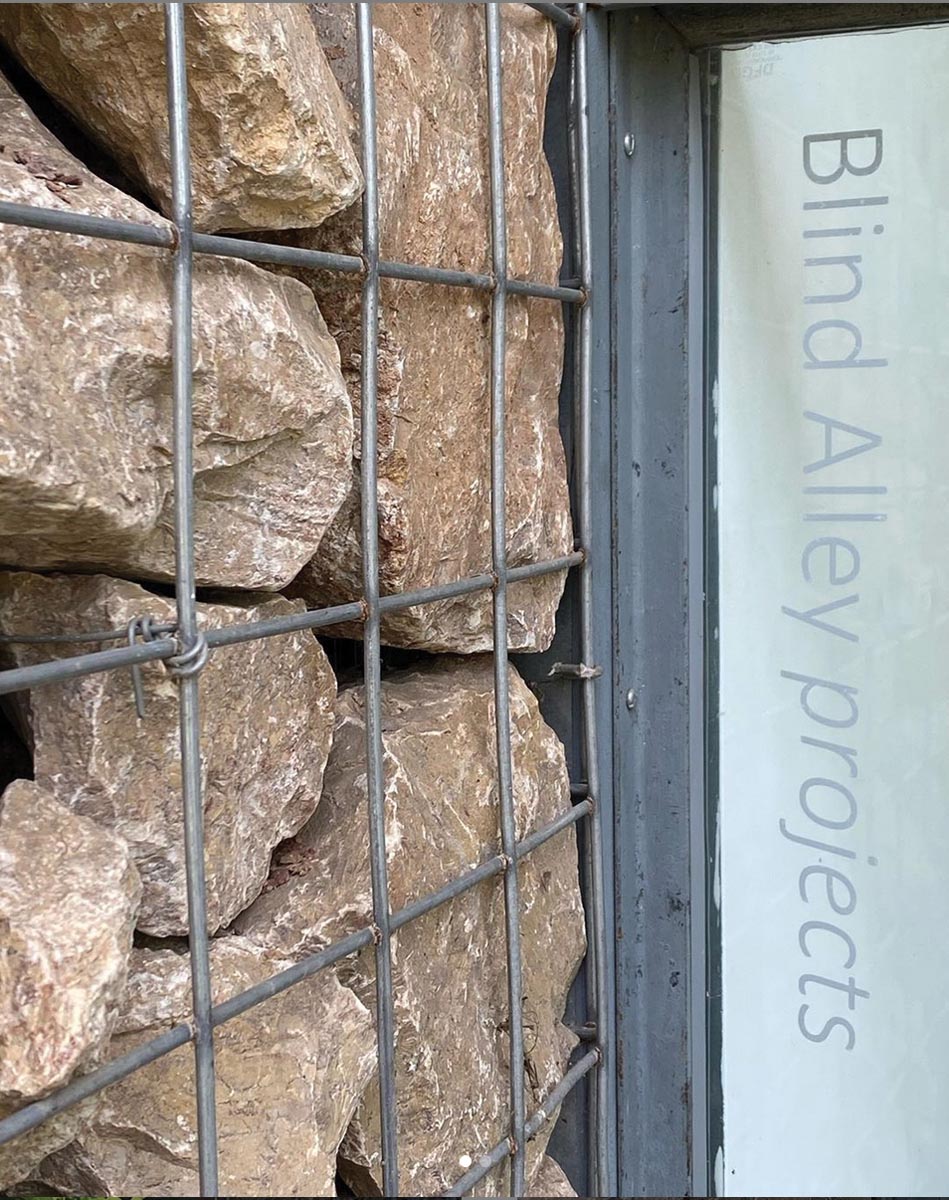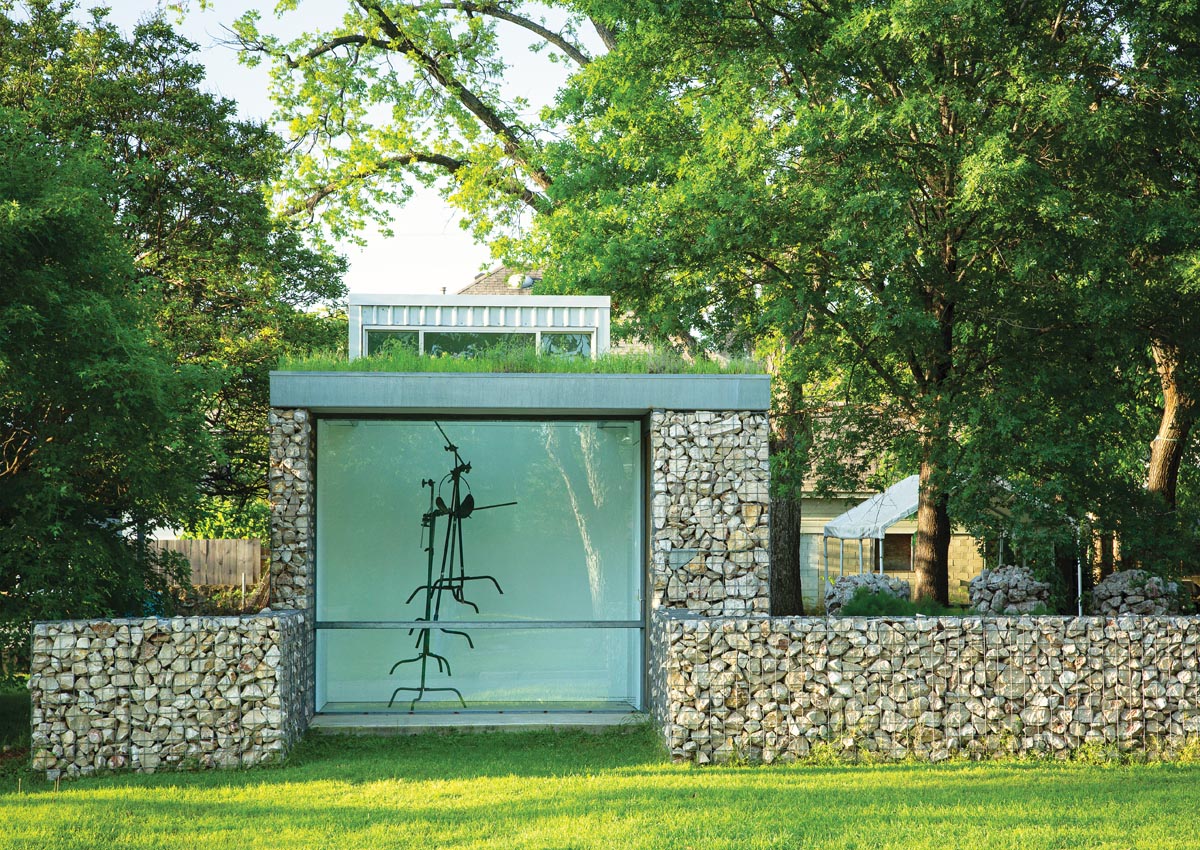
A New Direction
By Meda Kessler
Photo by Ralph Lauer
The pandemic prompts two Fort Worth artists to complete their long-in-the-works exhibition space. Blind Alley encourages innovation and discourages social gathering.
It’s been at least five years since artists Cam Schoepp and Terri Thornton completed Blind Alley, an off-the-grid exhibit space in a quiet neighborhood located minutes from Fort Worth’s museum district. The couple admit they’re kind of fuzzy on the actual date of conception, but they note that the true completion date was April 11, when at long last they installed an exhibit in the glass-walled structure. “We also had a short list of tiny details we had put off for years and that took us all of three days to finish up,” Thornton says. It was the COVID-19 outbreak that gave the couple the impetus and time to finally launch Blind Alley, which is designed to be viewed by a very limited number of people at one time or curbside from your car. “It felt like it was waiting for this moment,” says Thornton.
But first, a little background. Schoepp is a noted sculptor and professor of art at Texas Christian University. Thornton is known for her drawings and love of found objects; during the day, you’ll find her at the Modern Art Museum of Fort Worth, where she is curator of education and creator of the museum’s Tuesday-night lecture series. They live across the street from Blind Alley, which sits on a tree-shaded double lot also occupied by a Quonset hut-style studio shared by both artists. The same lot also is a pickup spot for a community-supported agriculture group on Sundays, as well as the site of Schoepp’s personal vegetable garden. Tall oaks occupy the corner occupied by Blind Alley, which is fenced on three sides by gabion walls that also form the skin of the structure. The couple came up with the name during a conversation with Michael Auping, then chief curator at the Modern. “We were talking about our idea for this project, and Michael was bemoaning the fact that artists don’t like to take risks and are unwilling to go down blind alleys anymore,” says Thornton. Newly christened, the project continued to move forward. Schoepp came up with a design and worked with Mark and Peter Anderson, principals of San Francisco-based architectural firm Anderson Anderson. The two brothers also happened to be Schoepp’s friends and undergrad classmates. The collaboration resulted in what Thornton calls a “magical” space, one that Schoepp built with the help of his brother and a couple of grad students. The 8-by-10-foot room with a glass front is the perfect blank canvas. There is no signage outside, and it has no lights inside. The living roof is lush with native grasses designed to attract bugs and birds, but there’s little else to detract from the display, fulfilling the mission of the space to be a unique alternative for the art community. “We wanted to take risks with the space and the art,” says Thornton. With the COVID-19 outbreak forcing the cancellation of presentations at TCU by Schoepp’s grad students, Blind Alley became the natural place to showcase their works. “It’s magical because it’s as if the universe were talking to us. They have to be the first,” says Thornton. “It really did launch the project.” Says Schoepp, “There’s no pressure to be a success here. We’re OK if you like it or if you don’t.” Maybe the world needs more Blind Alleys.
THE DETAILS
Blind Alley 3317 W. 4th St., Fort Worth, blindalleyprojects.com.
Find them on Instagram @blindalleyprojects. To contact, email blindalleyprojects@gmail.com.
Liminal Space Exhibitions by four TCU graduating MFA students represent ideas that would have been addressed in their thesis exhibitions before all programs and events at TCU were postponed or canceled because of the COVID-19 pandemic. Through May 6 Dario S. Bucheli, Out of Reach May 9-20 Sierra Forester, A Mass Well Dispersed is the Hardest to Confront May 23-June 3 Hector A. Ramirez, ENTRE PIEDRAS Y COPIA (between stones and copy) Look for summer exhibits from Texas sculptor Gene Owens, who apprenticed with Isamu Noguchi. Owens’ fountain at the Fort Worth Botanic Garden, “Runnels,” is made up of hand-formed ceramic blocks. Also in the works is an exhibit by Richard Wentworth, a British artist associated with the New British Sculpture movement in the 1970s.


